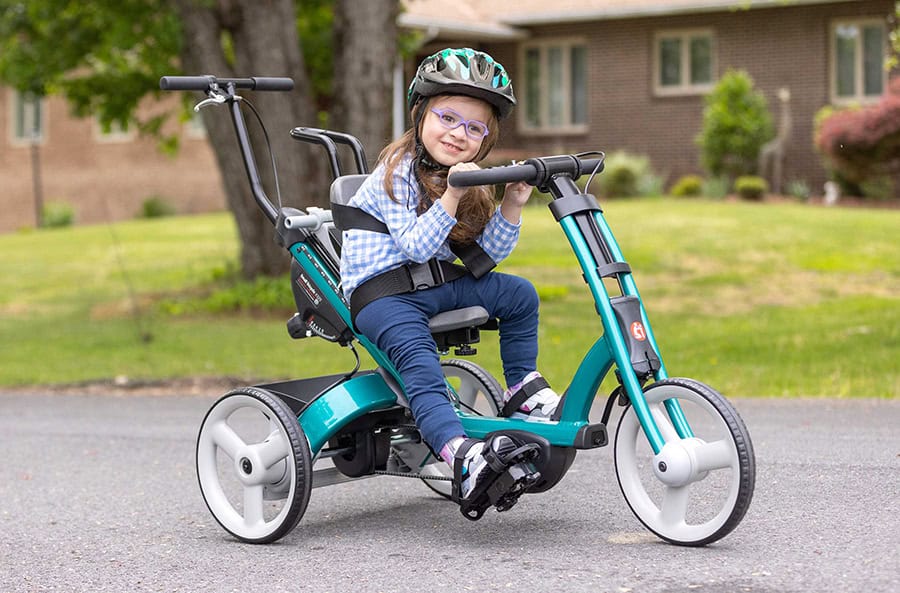
Kieran Murphy, Clinical Partnerships Manager for Jiraffe, sheds light on the pioneering world of adaptive seating, which is helping provide children of all ages with disabilities with a new lease of life.
Wheelchairs are universally recognised as being an ideal seating solution for children with physical disabilities, but that doesn’t mean they have to be the go-to solution.
Thanks to the extensive world of adaptive seating, a wider range of options that extend far beyond the humble wheelchair exist. And the even better news is children with disabilities can, and should, have access to them.
But perhaps more importantly, while these children require support that’s tailored to their specific requirements, they also need to be provided with more opportunities to encourage them to move, where possible.
This outlook was reinforced in 2021 with the publication of 24-hour activity guidelines for children and adolescents with cerebral palsy, with the core focus being on: “Balancing activity behaviours across the whole day, with improved physical activity, reduced sedentary time, and healthy sleep behaviours”.
Like most sectors, the adaptive seating industry has continued to rapidly evolve in recent years, producing an even wider range of solutions aimed at helping reduce sedentary behaviour and promote physical activity. These solutions include:
Adaptive seating solution 1: Activity chairs
Many of today’s activity chairs are highly versatile modular systems that incorporate a whole host of support options that span from the head to the feet. For instance:
Tilt-in-space functionality – provides varied seating positioning without compromising postural support. Tilting the entire chair into more upright or prone positions can be useful for increasing children’s level of alertness and attention while stimulating more active sitting.
Hi/lo functionality – improves access to the world around the child. Being low to the ground can be useful for floor play with peers while being higher is ideal for eye-to-eye interaction with carers.
Easy-to-adjust supports and age-specific designs – tool-free adjustment settings help make active sitting quicker and easier. In many designs, trunk, hip, and lower limb supports can all be easily adjusted to change seating positions while the child is sat in the chair.
Furthermore, certain industry-leading activity seats ‘grow’ with the child from infant to adulthood, thanks to their age-appropriate features and activity options. These include highly innovative mini kits that comprise of a backrest insert pad and mini trunk support and provide children as short as 28” with ample support. (Note: The kit also enables children to be positioned correctly at an earlier age and continue to be positioned correctly for longer before they outgrow the chair). The seat depth can also be adjusted while the child is seated, with the maximum length providing ample opportunities for them to practice sitting postures (long or ring sitting) that are typical for developing infants.
Adaptive seating solution 2: Dynamic seating
Dynamic seating enables movement within adaptive seating parameters to take place. It is also highly effective at:
Absorbing children’s extensor forces – that can potentially lead to activity seats breaking and children struggling to retain their seated position.
Providing children who need to move with sensory stimulation – children with sensory processing difficulties tend to fidget, rock and bounce while seated. Certain activity chairs feature dynamic seats and backrests that stimulate rocking motions. Some chairs even have dynamic feet that are specifically designed to support bouncing and wiggling.

Adaptive seating solution 3: Toileting, showering, and adaptive seating
There are, of course, many other different types of seats that can be used throughout the day for toileting, bathing, adaptive cycling, and more. This includes:
Toileting positioning chairs – enable effective toileting to take place by incorporating the squatting position that may aid effective voiding when toileting. Certain products also extend beyond toileting support – they double as a shower chair, thanks to the seat being able to be reclined enough to enable everyday tasks, such as hair washing, to take place with ease.
Adaptive tricycles – are designed to help improve leg strength, posture, balance and encourage a range of motion. They also help boost children’s socialisation and engagement with friends and family.
Some of the latest industry-leading adaptative tricycles help non-ambulatory people experience the joy and freedom of independent movement. With most models, the saddle seat isn’t too dissimilar to a typical bike seat, allowing for the cyclical motion of pedalling to take place.
It’s also important to note that adaptive tricycles offer a number of different sitting strategies. For example, children with increased extensor tone may benefit from their saddle seat being positioned more towards the backrest, which enables their lower limbs to be more extended. They may also benefit from their sandals being adjusted forward on their pedals, so they can use their plantarflexion tone to power them forward.
The world of adaptive seating is highly innovative, with newer and more intuitive models entering the market every year, making a positive impact on health and care professionals, children and their families. Because seating support no longer has to mean static; the opportunities are endless, and the benefits provided by these solutions are invaluable in helping children with disabilities live healthier, happier lives.
The post EXCLUSIVE: Take a seat – How adaptive seating options for paediatric disability are pushing the design boundaries and improving children’s lives appeared first on AT Today – Assistive Technology.
